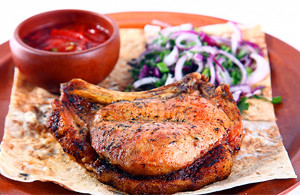 The Armenian cuisine is a poem, every line of which has a peculiar and unique scent. It includes a number of big and small secrets. Armenian cuisine consists of numerous kinds of vegetables and fruit, different sorts of herbs, cheese, meat and fish, wine and pastries. Cheese, herbs and lavash: any ceremonial dinner lovers, even those Armenians who live very far from their native country, never forget about their bread lavash. Lavash is a very thin, easily rolled layer of dough approximately one meter high, which is baked on a hot wall of a stove-tondir (stove dugged in the ground), which is burned and heated by a dry vine bough. After having traveled in the Caucasus, Alexander Dumas offered the French to taste khorovats (pieces of meat piled on a skewer and grilled on a burned charcoal without fire) with lavash, which he particularly liked. Basturma (long pieces of cured meat, covered with crust of bitter seasoning) and sujukh (flat meat sausages, spiced by various seasoning) are also very popular in Armenia. The biscuit gata (a flat cake of ferment or flaky dough with a filling of butter, sugar and flour) is very popular, too.
The Armenian cuisine is a poem, every line of which has a peculiar and unique scent. It includes a number of big and small secrets. Armenian cuisine consists of numerous kinds of vegetables and fruit, different sorts of herbs, cheese, meat and fish, wine and pastries. Cheese, herbs and lavash: any ceremonial dinner lovers, even those Armenians who live very far from their native country, never forget about their bread lavash. Lavash is a very thin, easily rolled layer of dough approximately one meter high, which is baked on a hot wall of a stove-tondir (stove dugged in the ground), which is burned and heated by a dry vine bough. After having traveled in the Caucasus, Alexander Dumas offered the French to taste khorovats (pieces of meat piled on a skewer and grilled on a burned charcoal without fire) with lavash, which he particularly liked. Basturma (long pieces of cured meat, covered with crust of bitter seasoning) and sujukh (flat meat sausages, spiced by various seasoning) are also very popular in Armenia. The biscuit gata (a flat cake of ferment or flaky dough with a filling of butter, sugar and flour) is very popular, too.
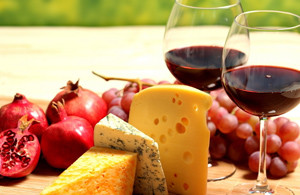 Wines as well as cheese occupy a particular page in culinary art. Roots of viticulture and winemaking in Armenia go back to the oldest times. It is confirmed by the cuneiform inscriptions in Urartu (an ancient state populated by Armenians). Wine cellars in Armenian houses were filled with aroma. There stood wide clay jars full of wine, grapes were dried for winter (which is popular in Armenia even nowadays), winter sorts of grapes, peaches, quinces and pears were piled on a thread and hung up. Nowadays numerous kinds of wine are produced in Armenia: “Malaga,” “Kagor,” Saperavi, pomegranate, Muscat, etc. Matchar (new grape wine) is very popular in Armenia. Combination of brightly shining sun of Ararat valley, fertile soil and pure water give the opportunity to create real works of art when producing wine and cognac. We offer you to try to cook some of the dishes, especially loved in Armenia, yourselves, in order to really appreciate all taste colorings of the Armenian cuisine.
Wines as well as cheese occupy a particular page in culinary art. Roots of viticulture and winemaking in Armenia go back to the oldest times. It is confirmed by the cuneiform inscriptions in Urartu (an ancient state populated by Armenians). Wine cellars in Armenian houses were filled with aroma. There stood wide clay jars full of wine, grapes were dried for winter (which is popular in Armenia even nowadays), winter sorts of grapes, peaches, quinces and pears were piled on a thread and hung up. Nowadays numerous kinds of wine are produced in Armenia: “Malaga,” “Kagor,” Saperavi, pomegranate, Muscat, etc. Matchar (new grape wine) is very popular in Armenia. Combination of brightly shining sun of Ararat valley, fertile soil and pure water give the opportunity to create real works of art when producing wine and cognac. We offer you to try to cook some of the dishes, especially loved in Armenia, yourselves, in order to really appreciate all taste colorings of the Armenian cuisine.
RECIPES
Cakes, Sweets
Gata
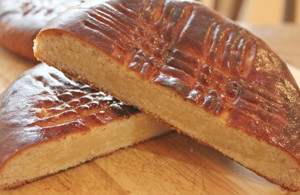 Yeast: 250 grams of flour, 250 grams of ferment, 200 grams of water. Pastry: 750 grams of flour, 200 grams of melted cream butter, 5 eggs, 200 grams of sugar, a pinch of salt, a pinch of vanilla. Filling: 800 grams of flour, 350 grams of melted cream butter, 300 grams of sugar powder. To spread egg yolk on gata topping. Make the yeast. Beat butter, melted beforehand, separately for 10 minutes: add sugar, eggs, vanilla, salt and mix until well blended. Fill it into the yeast and mix for 5 minutes. Afterwards, add flour with small portions (beating dough all the time), knead dough and put it in a warm place for 30-40 minutes. Filling: knead butter with flour, add sugar powder and vanilla. Put dough on a table covered with flour, knead it a little, cut it into some pieces of about 250 grams, and roll them into round pancakes of 0, 5 centimeters width. Spread butter on one pancake surface and put filling (1 cup), then close it with another pancake, join edges, spread egg yolk, put different patterns and prick some parts with a fork. Bake it in a frying pan covered with butter in the oven for 30-35 minutes.
Yeast: 250 grams of flour, 250 grams of ferment, 200 grams of water. Pastry: 750 grams of flour, 200 grams of melted cream butter, 5 eggs, 200 grams of sugar, a pinch of salt, a pinch of vanilla. Filling: 800 grams of flour, 350 grams of melted cream butter, 300 grams of sugar powder. To spread egg yolk on gata topping. Make the yeast. Beat butter, melted beforehand, separately for 10 minutes: add sugar, eggs, vanilla, salt and mix until well blended. Fill it into the yeast and mix for 5 minutes. Afterwards, add flour with small portions (beating dough all the time), knead dough and put it in a warm place for 30-40 minutes. Filling: knead butter with flour, add sugar powder and vanilla. Put dough on a table covered with flour, knead it a little, cut it into some pieces of about 250 grams, and roll them into round pancakes of 0, 5 centimeters width. Spread butter on one pancake surface and put filling (1 cup), then close it with another pancake, join edges, spread egg yolk, put different patterns and prick some parts with a fork. Bake it in a frying pan covered with butter in the oven for 30-35 minutes.
Meat Dishes
Khash 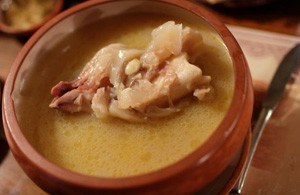 Scorch cleaned cow and ram trotters, scrape them, wash carefully and chop them up into pieces.
Scorch cleaned cow and ram trotters, scrape them, wash carefully and chop them up into pieces.
Leave them in cold water for some days (it is better to change the water every 2-3 hours). Wash the trotters again and put them into a large wide boiler, fill it with water (water must be higher than the trotters for 15-20 centimeters), cook it without salt not letting it boil very hard.
Constantly, skim off the scum.
It will be ready if the meat is picked off the bones easily. Khash is served very hot, and it is usually eaten early in the morning. Salt, dried lavash, chopped garlic and radish are served with khash.
Meat-Balls (4 portions) 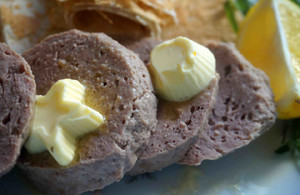 1,5 kilograms of beef 200 grams of melted butter 25 grams of onion Egg, 50 grams of milk, 12 grams of flour, 30 grams cognac, salt, pepper, greens to your liking. Separate meat from the bones (make broth with the bones) and beat them with wooden hammer, then put chopped onion on them, continue beating it until getting a soft mass. Add flour, milk, eggs, cognac to the mass and beat it with hand. When the mass is half-watery, sand salt, pepper, greens and put it into the fridge for 30 minutes. After that make small balls from the mass, make a hole, put little melted butter or well-boiled egg and give them a form of balls. Cook it in water or broth on a weak fire. Serve it with hot melted butter.
1,5 kilograms of beef 200 grams of melted butter 25 grams of onion Egg, 50 grams of milk, 12 grams of flour, 30 grams cognac, salt, pepper, greens to your liking. Separate meat from the bones (make broth with the bones) and beat them with wooden hammer, then put chopped onion on them, continue beating it until getting a soft mass. Add flour, milk, eggs, cognac to the mass and beat it with hand. When the mass is half-watery, sand salt, pepper, greens and put it into the fridge for 30 minutes. After that make small balls from the mass, make a hole, put little melted butter or well-boiled egg and give them a form of balls. Cook it in water or broth on a weak fire. Serve it with hot melted butter.
Armenian dolma with grape leaves
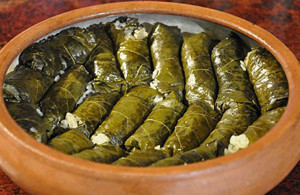 Ingredients
Ingredients
•1/2 kg of ground meat
•2 cups of rice
•1 white/red onion
•50 g of tomato paste
•parsley, coriander
•seasoning you like
•salt and paper
•grape leaves.
We take the meat, add the rice, add the onion cut into small cubes, then add already cut parsley and coriander (these are optional), add the tomato paste, the seasonings, salt and paper and mix all of these thoroughly.
Then If you choose to make dolma with grape leaves you put them in water and boil for about 15-20 minutes. If you want to make it with cabbage , you again put it in water and boil it just a little bit, so that its leaves become just a bit flexible, enough to roll them.
So, after we have the grape leaves/cabbage ready to use, we take the meat mixture, take a table spoon of it and put on the leaf(grape or cabbage). Then start making accurate rolls(bend the sides of the leaf to the middle and start rolling from the bottom to the top).
After we are done with making the rolls we place them into a big pot, where we initially put either some grape leaves or cabbage(depending on which dolma we are making). After carefully placing all the rolls in the pot we add water (so that it covers almost all of the rolls), put tomato cut into small slices on the top, then we put a plate on top of all of it (so that the rolls don’t undo themselves).
We keep it on the fire for about 40 minutes to 1 hour(depending on how strong the fire is), when it starts smelling nice, we take one to try whether the meat inside is cooked. If it is, we put the rolls on the plate and serve it hot.
Armenian cuisine
- 4890



